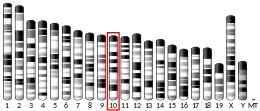GIPC3
PDZ domain-containing protein GIPC3 is a protein that in humans is encoded by the GIPC3 gene.[5][6] GIPC3 is a member of the GIPC (GAIP-interacting protein C terminus) gene family that also includes GIPC1 and GIPC2.[7] The encoded protein, GIPC3, features a centrally located PDZ domain, which is flanked on each side by a single GIPC-homology domain.[8]
| GIPC3 | |||||||||||||||||||||||||||||||||||||||||||||||||||
|---|---|---|---|---|---|---|---|---|---|---|---|---|---|---|---|---|---|---|---|---|---|---|---|---|---|---|---|---|---|---|---|---|---|---|---|---|---|---|---|---|---|---|---|---|---|---|---|---|---|---|---|
| Identifiers | |||||||||||||||||||||||||||||||||||||||||||||||||||
| Aliases | GIPC3, C19orf64, DFNB15, DFNB72, DFNB95, GIPC PDZ domain containing family member 3 | ||||||||||||||||||||||||||||||||||||||||||||||||||
| External IDs | OMIM: 608792 MGI: 2387006 HomoloGene: 77068 GeneCards: GIPC3 | ||||||||||||||||||||||||||||||||||||||||||||||||||
| |||||||||||||||||||||||||||||||||||||||||||||||||||
| |||||||||||||||||||||||||||||||||||||||||||||||||||
| |||||||||||||||||||||||||||||||||||||||||||||||||||
| |||||||||||||||||||||||||||||||||||||||||||||||||||
| Wikidata | |||||||||||||||||||||||||||||||||||||||||||||||||||
| |||||||||||||||||||||||||||||||||||||||||||||||||||
Function
GIPC3 is thought to be important for acoustic signal acquisition and propagation in hair cells of the mammalian cochlea.
Gene
The human GIPC3 gene is located on the short arm of chromosome 19 at p13.3. The locus extends over about 8 kbp and contains the six coding exons that give rise to an open reading frame of 639 nucleotides encoding the GIPC3 protein of 312 amino acids. A single PDZ domain is located at amino acid position 122-189. In the mouse, Gipc3 is located on chromosome 10 at cytogenetic band qC1. The genomic region covers a distance of 5.5 kbp. The six coding exons encode a protein of 297 amino acids. The PDZ domain is located at amino acid position 107-174.
Genetics
In the mouse, a missense mutation in Gipc3 (c.343G>A) leads to a non-synonymous amino acid replacement (p.G115R) in the loop connecting two beta strands of the PDZ domain. Glycine 115 is conserved in all GIPC proteins.[9] Missense (c.785C>T; p. L262R) and nonsense (c.903G>A, p.W301X) mutations in human GIPC3 cause congenital sensorineural hearing impairment in families segregating non-syndromic hearing loss DFNB15 and DFNB95.
Phenotypes
Mice of the Black Swiss strain develop early-onset slowly progressing sensorineural hearing loss. A genetic study identified two quantitative trait loci (QTL) that control hearing function. One QTL, named age-related hearing loss 5 (ahl5) localizes to chromosome 10 and accounted for ca. 60% of the variation in hearing thresholds. A second QTL, ahl6, localized to chromosome 18 and has a smaller effect size.[10] Besides their hearing impairment, Black Swiss mice also are hypersensitive to acoustic stimulation, reacting with seizures (audiogenic seizures) to loud white noise.[11] A genetic locus conferring susceptibility was identified (juvenile audiogenic monogenic seizures1, jams1) on chromosome 10. A positional cloning approach aimed to decipher the genetic basis of both the hearing loss and audiogenic seizure susceptibility subsequently identified the glycine to arginine substitution in Gipc3 as the underlying cause.
In humans, individuals with the p.W301X missense mutation (DFNB95) exhibit bilateral sensorineural hearing loss with threshold shifts of 70-80 dB hearing levels as early as 11 months of age.
Interactions
The PDZ domain of GIPC family proteins interact with:[7]
See also
References
- GRCh38: Ensembl release 89: ENSG00000179855 - Ensembl, May 2017
- GRCm38: Ensembl release 89: ENSMUSG00000034872 - Ensembl, May 2017
- "Human PubMed Reference:". National Center for Biotechnology Information, U.S. National Library of Medicine.
- "Mouse PubMed Reference:". National Center for Biotechnology Information, U.S. National Library of Medicine.
- "Entrez Gene: GIPC PDZ domain containing family".
- Saitoh T, Mine T, Katoh M (March 2002). "Molecular cloning and characterization of human GIPC3, a novel gene homologous to human GIPC1 and GIPC2". Int. J. Oncol. 20 (3): 577–82. doi:10.3892/ijo.20.3.577. PMID 11836571.
- Katoh M (June 2002). "GIPC gene family (Review)". Int. J. Mol. Med. 9 (6): 585–9. doi:10.3892/ijmm.9.6.585. PMID 12011974.
- Katoh, M. (2002). "GIPC gene family (Review)". International Journal of Molecular Medicine. 9 (6): 585–589. doi:10.3892/ijmm.9.6.585. PMID 12011974.
- Charizopoulou N, Lelli A, Schraders M, Ray K, Hildebrand MS, Ramesh A, Srisailapathy CR, Oostrik J, Admiraal RJ, Neely HR, Latoche JR, Smith RJ, Northup JK, Kremer H, Holt JR, Noben-Trauth K (February 2011). "Gipc3 mutations associated with audiogenic seizures and sensorineural hearing loss in mouse and human". Nat Commun. 2 (2): 201. Bibcode:2011NatCo...2..201C. doi:10.1038/ncomms1200. PMC 3105340. PMID 21326233.
- Drayton, M.; Noben-Trauth, K. (2006). "Mapping quantitative trait loci for hearing loss in Black Swiss mice". Hearing Research. 212 (1–2): 128–139. doi:10.1016/j.heares.2005.11.006. PMID 16426780. S2CID 23928550.
- Misawa, H.; Sherr, E. H.; Lee, D. J.; Chetkovich, D. M.; Tan, A.; Schreiner, C. E.; Bredt, D. S. (2002). "Identification of a monogenic locus (jams1) causing juvenile audiogenic seizures in mice". Journal of Neuroscience. 22 (23): 10088–10093. doi:10.1523/JNEUROSCI.22-23-10088.2002. PMC 6758732. PMID 12451109.
Further reading
- Vega A, Salas A, Milne RL, et al. (2009). "Evaluating new candidate SNPs as low penetrance risk factors in sporadic breast cancer: a two-stage Spanish case-control study". Gynecol. Oncol. 112 (1): 210–4. doi:10.1016/j.ygyno.2008.09.012. PMID 18950845.
- Matsuoka S, Ballif BA, Smogorzewska A, et al. (2007). "ATM and ATR substrate analysis reveals extensive protein networks responsive to DNA damage". Science. 316 (5828): 1160–6. Bibcode:2007Sci...316.1160M. doi:10.1126/science.1140321. PMID 17525332. S2CID 16648052.



